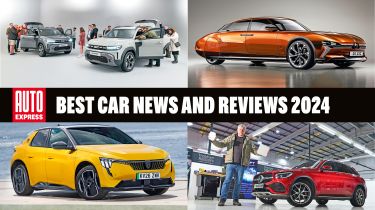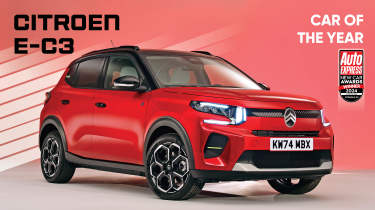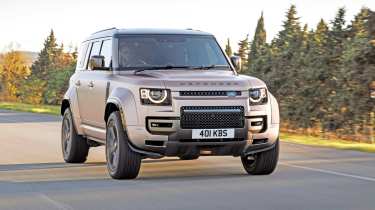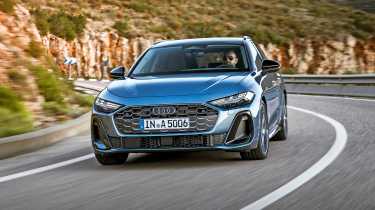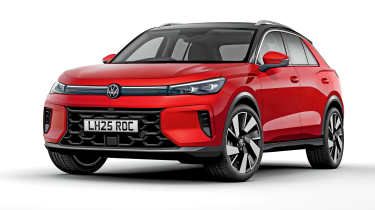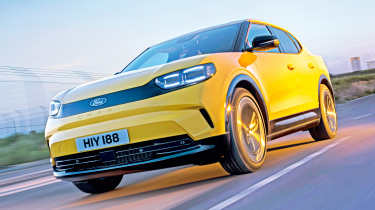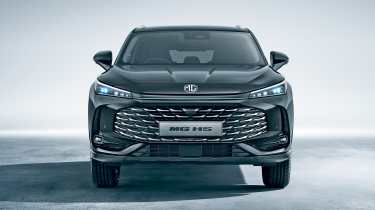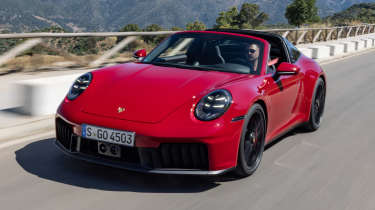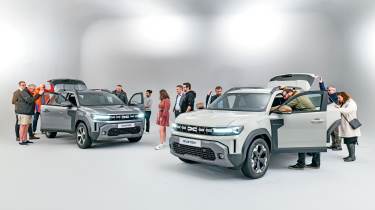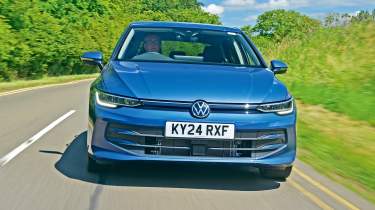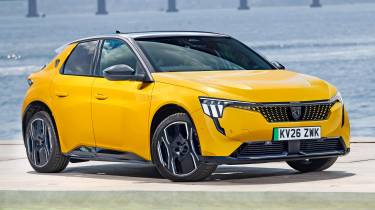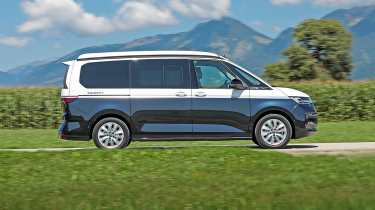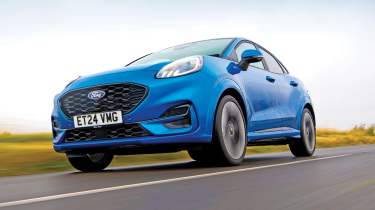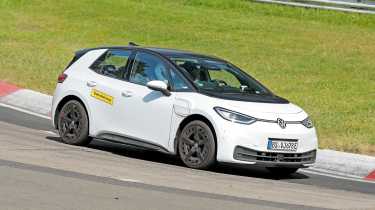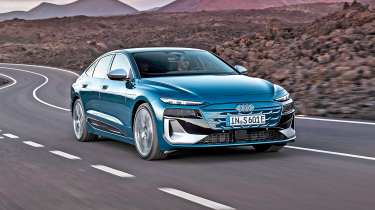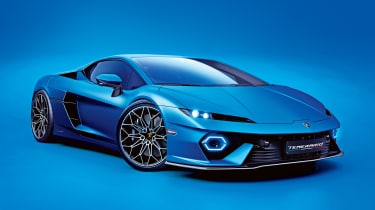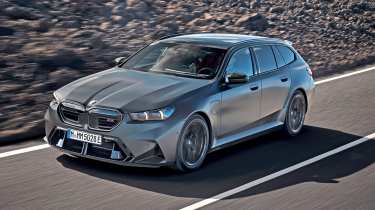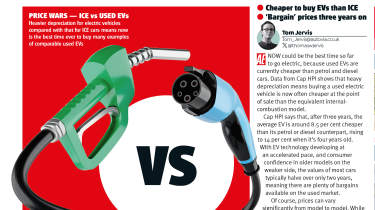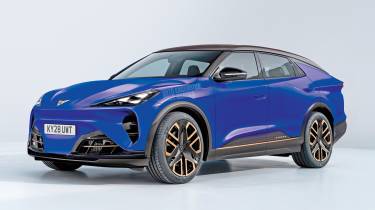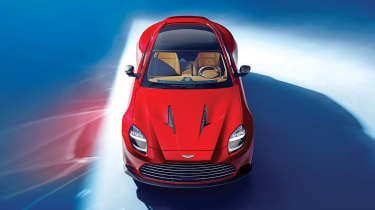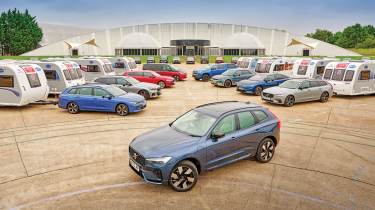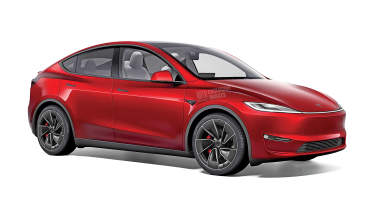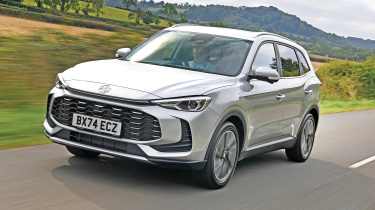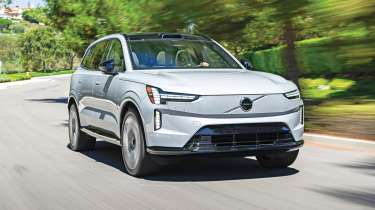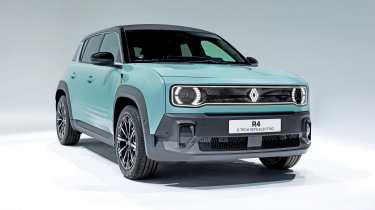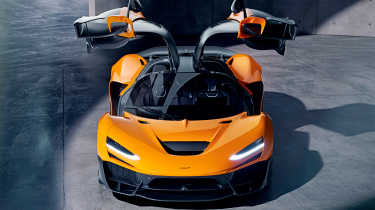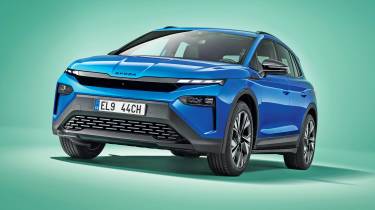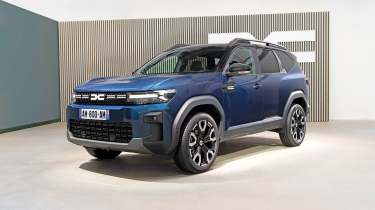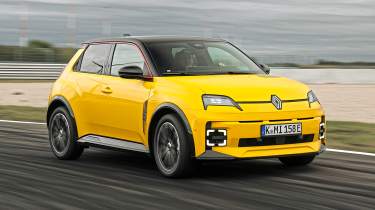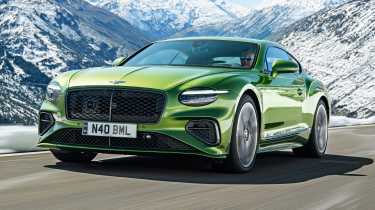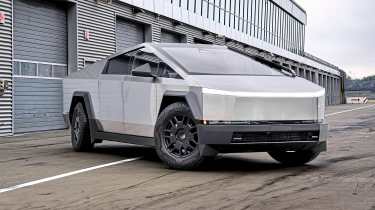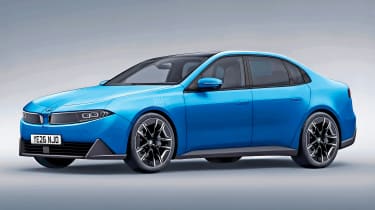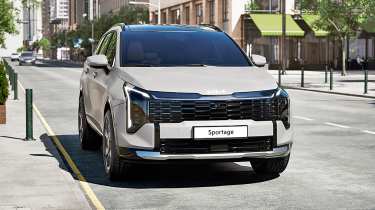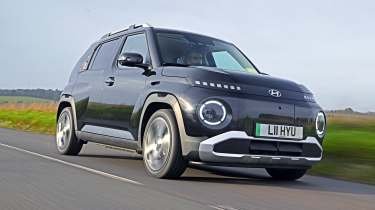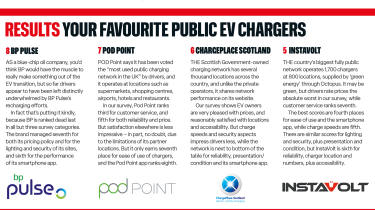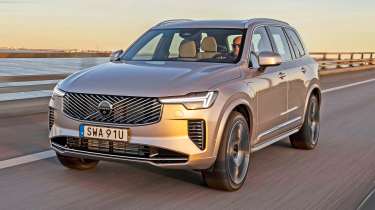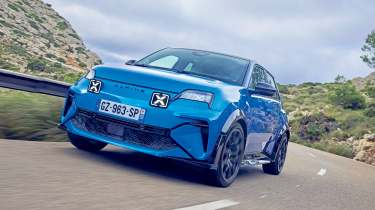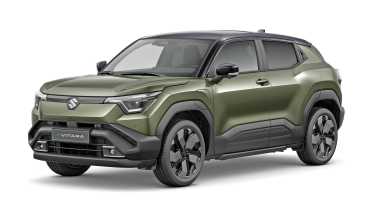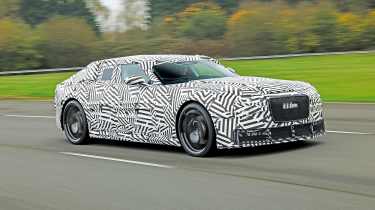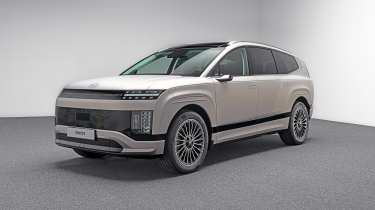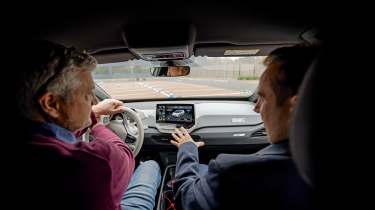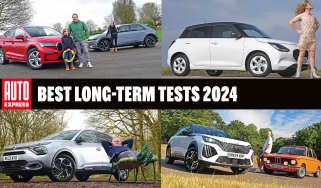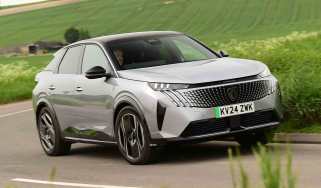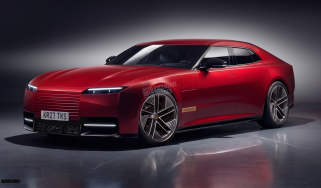Best car news and reviews 2024 - July to December
We look at the highlights and delights that stood out in a fully packed 2024
July
Car of the Year winners revealed
Our 2024 New Car Awards saw us pitting the very best models in each segment against each other once again. From pint-sized city cars to load-lugging pick-up trucks, each highly rated vehicle vied to take home a class title.
The honour of being Auto Express Car of the Year for 2024 went to the all-new Citroen e-C3. Our judges were the first people to drive the car on UK roads, and were impressed by the ride, interior space and low running costs. The cherry on top was the starting price of less than £22,000, which is close to half that of last year’s overall winner, the Hyundai Kona Electric. Our reviewer said in their verdict: “There’s a distinct feeling of ‘perfect car at the perfect time’ for the e-C3. It’s the first usable small electric car that’s the same price as petrol alternatives without any obvious compromises.”
It offers 199 miles of range, with space for four adults and their luggage, and the competitive price secured the e-C3’s second win as our Affordable Electric Car of the Year. Plus the C3 range as a whole also took our Supermini of the Year honour, Citroen's third award of the evening and an impressive haul for the French manufacturer.
Hyundai managed to top that, though, with a total of four category wins across its range. The i10 retained its title as City Car winner, as did the Kona Electric in the Small Company Car class. Mid-size SUV of the Year went to the Tucson and the ballistic Ioniq 5 N scooped Performance Car. Sister brand Kia also claimed the Large Company Car award with its flagship EV9.
The Dacia Duster won two awards – Small SUV of the Year for the Mk3, while the Mk2 won our Driver Power Award, based on feedback from owners. Skoda took gongs for the new Kodiaq, Superb Estate and facelifted Octavia, and Ford won big in the commercial vehicle categories with its Ranger pick-up truck and Transit models. BMW and Porsche both picked up two awards, and there were wins for MG, Tesla, MINI, Lexus, Honda, Mazda and Maserati too.
Defender Octa serves up 626bhp
After three years of testing in some of the world’s toughest conditions, the almighty Land Rover Defender Octa was finally revealed.
Its 626bhp twin-turbo V8 allows for 0-60mph in a ferocious 3.8 seconds, but equally impressive is the addition of the brand’s new 6D Dynamics suspension system, with different modes for tearing up tarmac and destroying desert dunes. Other chassis revisions include upgraded brakes, the fastest steering ratio of any Defender, and wider wheelarches. The price? A cool £160,000.
Audi replaces the A4 with the A5
If you thought Christopher Nolan’s films were confusing, in July, what was once the Audi A4 became the new A5.
The logic is that Audis with even-numbered badges are now all-electric, and those with combustion engines use odd numbers.
Regardless, the BMW 3 Series rival was revealed as a coupé-like five-door Sportback and more practical Avant, with a mix of petrol and diesel engines, including a 362bhp V6 in the S5 quattro. Audi also announced two plug-in hybrids for 2025, with 62 miles of EV range.
New Volkswagen T-Roc to be the company's last ICE model
The Volkswagen T-Roc is one of the most popular models in the brand’s line-up, but that’s not the only reason why the second generation will be so important. It’ll also be the last combustion-engine model VW launches ahead of an all-electric future.
As our image shows, the T-Roc is set to borrow heavily from the Tiguan in terms of its exterior styling, while the interior design and engine tech will also be the same. VW’s latest and cleanest mild-hybrid petrol, diesel and plug-in hybrid motors are all likely to feature.
Legendary Capri name makes an electric return
Ford fans and children of the eighties had been sharpening their pitchforks since Auto Express revealed the Capri name would be returning on an electric SUV.
Needless to say, when the all-new plug-in Capri stepped out of the shadows and into the limelight, the brand tested the ‘all publicity is good publicity’ adage to breaking point.
We spoke to Ford’s European design chief, Murat Gueler, to understand how the new Capri is supposed to keep the spirit of its ancestors alive. He responded, “For us it's more of an exercise in personality,” before pointing to the modern reinterpretations of elements from classic generations. The biggest hint being the dog-bone front with round headlights, as well as the horizontal roofline and rounded C-pillar.
Of course, it didn’t take long for people to start comparing the Capri’s silhouette with that of the Polestar 2. Ford admitted there were several components, like the front bumper, bonnet and doors, shared with the latest Explorer SUV, while the interior was carried over almost wholesale, save for the metal-effect spoke on the steering wheel, with cut-outs as a subtle nod to the Cortina that the original Capri was based on.
The two Fords share the same platform too – the Volkswagen Group’s MEB architecture – so the Capri is also related to the Skoda Enyaq and VW ID. Buzz, and Ford launched it with a choice of two electric powertrains.
The first gets a 77kWh battery and a 282bhp motor, with rear-wheel drive for a 390-mile range and 0-62mph in 6.3 seconds. The top version has a 79kWh battery and 335bhp dual-motor layout, plus all-wheel drive, to hit 62mph in 5.4 seconds, and return 348 miles of range.
Order books opened immediately, with prices from £48,075. However Ford said that would fall to nearer £42k next year with an entry model.
New MG HS offers great-value pricing
The second-generation MG HS might not have been the brand’s most exciting offering this year, but the popularity of its predecessor made it the most important.
Aggressive pricing and value meant the mid-size SUV was already off to a good start, and we found interior quality, technology and practicality were improved over the last HS. However, after feeling nonplussed by the petrol model, we recommended readers wait for the incoming hybrid for a more refined driving experience.
Hybrid 911 GTS gives good first impression
This year, the inevitable happened: the Porsche 911 adopted hybrid technology, and the first model to feature the 'T-Hybrid' set-up was the 911 GTS.
It not only boosts efficiency but also reduces lag left by the car’s new, specially developed 3.6-litre flat-six engine. The result is captivating, with the responses and feel of a naturally aspirated engine; and with the most extreme drive mode activated, the GTS responds like no other turbo Porsche we’ve ever driven.
Dacia Duster deep dive
The all-new Mk3 Dacia Duster was one of the most hotly anticipated cars of 2024, an icon of the Dacia brand that we know you, our readers, are huge fans of.
That's why we went behind the scenes to get exclusive insights into the development of the recently anointed Auto Express Small SUV of the Year in our whopping, continent-crossing 32-page Duster deep dive.
We went off road at Renault’s Aubevoye test facility in Normandy, France, then spent a night with Dacia’s VP of design, David Durand, in the Spanish wilderness, learning about how the brand hopes to continue winning hearts and minds. Plus, we were among the first people to try out the new Duster’s Sleep Pack.
For even more detail, we donned our lab coats to go inside Dacia's Romanian factory, then we headed to Oxfordshire, for some studio time with the car and a few previous-generation Duster owners, to find out what they made of it in the metal. The lack of a diesel disappointed a few, but the new, more modern design proved to be an absolute hit.
Mk8.5 facelift brings VW Golf improvements
The VW Golf has seen a fall from grace in recent years due to the eighth generation’s sub-standard interior and poor user interface.
VW hoped to right some of those wrongs with a major remodeling for the new Mk8.5, which added more intuitive software, proper buttons for the steering wheel, and illuminated touch-sensitive controls on the dash. We appreciated the improvements, and the Golf was still comfortable, well equipped and just the right size for many people, however it wasn’t enough to restore its status as the default family car pick.
Viper seems to be lacking in venom
We may not have the same amount of reverence for the Dodge Viper on this side of the pond as those in the USA, but there’s no denying the sports car with its gigantic 8.0-litre V10 engine is a motoring icon.
Route 66 was booked up, so we got to drive the one of the first Vipers on a deserted B-road on the Isle of Man instead. No modern car looks as outrageous as the Viper, but sadly its dynamic abilities weren’t as impressive, and the monstrous engine lacked the expected drama.
August
Scoop preview of next Peugeot 208
One of our most attention-grabbing stories of 2024 was an exclusive scoop on the next-generation Peugeot 208, with the inside track on the new supermini that’s ready to break some rules when it arrives in 2026.
As our exclusive images show, the latest Peugeot 3008 and 5008 SUVs are likely to influence the 208's design, sharing their graduated grille pattern, sharp headlights with the brand’s signature three-claw light motif, and unconventional wheel designs. The rear will have some angular surfacing, and a black strip joining the tail-lights with bold ‘Peugeot’ lettering across it, as is fashionable these days.
The sister car to the Vauxhall Corsa is sure to be flamboyant, but that was a given. However, the biggest changes will come in the cabin. The next 208 will take its lead from Peugeot's radical Inception concept of 2023. Its unique ‘Hypersquare’ steering wheel is likely to form part of the next generation of Peugeot’s i-Cockpit cabin layout.
The news came from a chat with Peugeot design director Matthias Hossann, who told us: “I will not call it a steering wheel; it is a new device for driving. But why are we designing that? It’s the ‘by wire’ technology – you don’t have any mechanical connection. It allows us to create a new driving sensation: super-agile and super-efficient.” Hossann also revealed that the company is testing the new technology in a prototype car. “In 2026 we will implement this," he said. "It changes everything”.
Meanwhile, the wheel design is likely to be less busy than those in current Peugeots. As Hossann put it, “When you design a race car, you can control all your car with your fingertips, and this is the same idea.” However, the design boss assured us that Peugeot won’t be going as minimalist as Tesla.
“We could have decided to put the indicator [on the wheel], but we decided to keep some heritage. We keep some function behind [the wheel], but in terms of shape, it will be close to this,” he said.
California dreaming in new VW camper
Volkswagen’s home away from home, the California camper van, is a legend among its peers, and has plenty of fans in the Auto Express office. We spent two days living in the latest model to see if it's worthy of our affections, and were impressed by what a comfortable and refined cruiser it was.
We took note of the clever features onboard, too, but felt compromises had been made due to the new California being based on the Multivan MPV, rather than the imminent T7 Transporter.
Ford's new-look Puma is still a winning formula
The Ford Puma was the UK’s best-selling car in 2023, and by some margin. In order to prevent its popularity from waning, the small SUV was given a mid-life facelift that only included one or two styling tweaks, but a major cabin overhaul that added bigger screens to please more tech-savvy motorists. In August, we finally got to see if that was enough to keep it on top form.
The original interior was a bit of a weak spot in this otherwise great SUV, particularly the quality of its small, laggy central touchscreen. The new dashboard layout addressed that by swapping in a much larger 12-inch display, running Ford’s latest SYNC 4 infotainment software. Both were big improvements, because the menus loaded quickly and were easy to navigate and read.
Similarly, the driver got a new 12.3-inch instrument display, behind a squared-off steering wheel. However, we did mourn the loss of physical climate controls. We were also disappointed that the fit and finish was much the same as before, with too many hard surfaces.
Practicality was unchanged of course, and still a strong point of the Puma thanks to the 456-litre boot with its 68-litre ‘Megabox’ under the floor. The same goes for the driving experience, which, as we put it, “continues to shine in a class of otherwise safe and sanitised SUVs”.
With good levels of grip and a well balanced chassis, the Puma is playful and still the most
fun small SUV to drive. However, the automatic gearbox in our test car proved to be sluggish, which is why we recommended drivers opt for the standard six-speed manual, which provides a more engaging driving experience, too.
Despite the refreshed Puma costing more than some rivals, after driving it, we knew it wouldn’t be relinquishing its place close to the top of the sales charts any time soon.
Volkswagen ID.2 spotted testing
The Volkswagen ID.2 will be one of the most important new cars to arrive in 2025, and will essentially press the reset button for the brand after its first batch of pure-electric models failed to leave a particularly positive impression.
VW is keeping everything close to its chest regarding the Polo-sized EV, which is why the first prototype we spotted on the Nürburgring is disguised by the shortened body of an existing ID.3. For now, we’re keeping our fingers crossed that the real design stays true to the ID.2all concept that stole our hearts in 2023.
Electric-only Audi A6 e-tron breaks cover
First promised in 2021, the new Audi A6 e-tron was revealed in August, as both a Sportback-style saloon and slick Avant estate.
The pair use the same PPE architecture as Audi’s Q6 e-tron SUV and the Porsche Macan Electric, with headline-grabbing figures including a 466-mile range and 270kW peak charging speeds – enough to add 200 miles worth of juice in 10 minutes. Topping the line-up for now is the 496bhp S6 e-tron, but we’re expecting a full-fat RS 6 e-tron to follow shortly.
Fresh Lambo revealed with twin-turbo V8
The Lamborghini Huracan and its glorious V10 engine were barely six feet under when its replacement completely stole the show at Monterey Car Week, and provided yet more proof that hybrid cars don’t have to be boring.
The all-new Lamborghini Temerario – which means daredevil, fearless or reckless depending on which translation you like best – doesn’t have ten naturally aspirated cylinders like the Gallardo or Huracán that came before it. Instead, the beating heart of its triple-motor plug-in hybrid powertrain is a 4.0-litre, twin-turbo V8 with a flat-plane crankshaft and 10,000rpm red line – a suitable substitution, if you ask us.
The engine delivers 789bhp between 9,000rpm and 9,750rpm, plus 730Nm of torque, supplemented by three electric motors to give the Temerario a total power output of 907bhp. Enough, Lamborghini says, for 0-62mph in 2.7 seconds and a top speed in excess of 210mph.
The first e-motor is between the engine and transmission, with 300Nm to help minimise turbo lag. The other two are on the front axle to deliver four-wheel drive and torque vectoring to boost agility.
BMW announces new M5 Touring
For the third time in the BMW M5’s 40-year history, the iconic super-saloon is being joined by a load-lugging estate version.
Not wanting to show the Audi RS 6 Avant any mercy, the new M5 Touring produces 717bhp and 1,000Nm of torque from a plug-in hybrid V8 powertrain, sending its colossal grunt to all four wheels. It can carry up to 500 litres of luggage in the boot, as well as doing 0-62mph in 3.6 seconds – just 0.1 seconds slower than the saloon.
Electric cars become cheaper than ever
Depreciation is an increasingly thorny problem for EVs, but in the summer we celebrated the fact that you could buy a used one for less than an equivalent petrol model.
We listed EV bargains including the Vauxhall Corsa, MG ZS, and Volvo XC40, which could all be had for £1,000 less than their ICE equivalents according to data from CAP HPI. It wasn’t a clear picture across the board, with more in-demand models like the BMW i4 still commanding prices higher than their ICE stablemates.
September
A new-look mag – but still the same values
September is always a huge month for the car industry. Whether it’s all-new model reveals, events granting the motoring press the chance to try out the latest metal on the road for the first time, or even the new reg plate for UK buyers, there’s an awful lot to take in. But September 2024 was even more significant than usual for Auto Express, because we launched one of the most significant rebrands of our 36-year history.
Much like all of the best facelifts in the automotive world – the sorts that we bring you before anyone else – we hope you’ll agree that our new layout has taken little time in making our previous style seem a touch dated. While the fresh new logo was the standout introduction of the rebranding, the magazine has been re-jigged with bolder colours, punchier fonts and new layouts that allow us to pack in even more news, reviews and consumer stories than ever before.
In addition to the fresh look, we overhauled our road tests, with comparisons that dig deep into each car’s most miniscule aspects, so that we can assess as many new models as possible. The outcome of these comparison tests is vital when it comes to judging the winners in our annual New Car Awards, because these direct back-to-back comparisons give a precise barometer of the various new-car class leaders.
We were pleased to have achieved all of this while maintaining the gold mine of advice found in our extensive product tests, plus all of the buying guides and weekly columns, too.
The redesigned magazine was launched alongside a newly refreshed website, enabling you to access all the latest news as and when it breaks, plus much of the great content found in the print edition every Wednesday.
But we also wanted to emphasise that this redesign didn’t change our commitment to our readers. Without your support, none of this would be possible. We always aim to give you a voice, and that’s why we always appreciate your feedback – no matter how small.
Cupra to expand into US with new big SUV
Another week, another Auto Express scoop, as we exclusively revealed that Spanish brand Cupra is set to launch in the US market – introducing a new large crossover SUV to spearhead its arrival.
This car will come to Europe, and Cupra CEO Wayne Griffiths confirmed that it would be a five-seater. Dr Werner Tietz, the firm's vice-president for research and development, added that Cupra is working on ‘concepts that are different,’ and we speculated that the new car will adopt a coupé-SUV shape.
Aston’s Vanquish GT takes the spotlight from its Ferrari rival
Ferrari’s 12Cilindri only had a couple of months in the limelight before Aston Martin waded in with its own V12 GT car, which saw the Vanquish name return in spectacular style – literally, thanks to its jaw-dropping carbon-fibre body and some spectacular numbers.
We noted its 5.2-litre twin-turbo V12 pumping out 823bhp and 1,000Nm of torque, enough for a 0-62mph time of 3.3 seconds and a 214mph top speed. As expected, buyers will need deep pockets to get hold of Aston’s flagship due to its third-of-a-million pound asking price.
Volvo’s XC60 secures fab four titles at annual towcar awards
As usual, we joined the Caravan and Motorhome Club at the Millbrook test facility to help judge the Towcar of the Year Awards, a fiercely fought competition with an entry list that’s increasingly skewed towards EVs – quite a challenging prospect for many towers!
The supremely competent Volvo XC60 T6 AWD plug-in hybrid won, so caravanners didn’t have any range-anxiety issues. As well as naming it the Towcar of the Year, judges also acclaimed the XC60 as best in the over 1,800kg tow class, best hybrid and best family towcar.
Top-selling Tesla Model Y is set to get major revamp
The world’s best-selling car in 2023 was the Tesla Model Y. But as we revealed through our exclusive renders, the US brand shows no sign of resting on its laurels, because we announced that a heavily revised model – currently named ‘Project Juniper’ – will take the current car’s place in 2025.
We based our renders on one or two leaked images which, while showing only small details, were quite revealing as to how Tesla plans to differentiate the revamped Y from the smaller Model 3. A criticism of the current car is that, aside from its slightly taller proportions, it looks barely different to its pre-facelift saloon sibling.
Those criticisms look set to be silenced next time around, because the image showed a full-width light bar on the boot lid, featuring Tesla lettering spanning its width. Our renderings predict that this will be bookended by a much sharper tail-light design, which will bear a similar C-shape to that of the revised Model 3.
The front of the 3 was also refreshed in 2023 with much slimmer, sharper lights, which also served to deliver marginal gains in aerodynamic efficiency. We expect the same of the new Model Y, but a full-width light bar might also feature at the front to mirror the design at the rear.
While we had little chance to glean much information from the leaked interior render, there’s a strong chance that the new Model Y’s cabin design will be nearly identical to that of the latest Model 3. That means even fewer buttons, with even the drive selector moved onto the large, central touchscreen, and indicators taking the form of steering wheel-mounted buttons instead of traditional column stalks.
But one thing we are confident of is class-leading range, charging and performance stats. Tesla already leads the way in these areas, and that will only improve with the new car. The Model 3 also gained a big boost in refinement and comfort in 2023, and given the current Model Y can ride harshly, we’re hoping for the same improvements in these areas, too.
MG follows EV success with hybrid ZS model
MG has hit the big time in the UK with a range of EVs with rock-bottom prices, but it’s expanding its horizons with hybrid tech, too.
The £21,995 MG ZS Hybrid SUV gets the same petrol/electric powertrain as the MG3. Yet that should really be an electric/petrol set-up, because with 134bhp on its own, the ZS’s e-motor makes much more power than the four-cylinder petrol engine under the bonnet. The result is class-leading performance and response, and pretty impressive fuel economy.
EX90 has big numbers, including its price tag
“Classy, spacious, decent to drive and exceptionally refined” were the words we used to sum up the all-new Volvo EX90, a car that combines those positive driving impressions with some fairly spectacular numbers.
The Swedish brand’s flagship EV has seven very spacious seats, while the powertrain pairs a 107kWh battery pack with 250kW charging, and is driven by a 510bhp twin-motor set-up. The biggest number of all, however, comes from the price: the range-topping EX90 costs £100,555.
October
Renault 4 reinvented for EV age
Renault grabbed the headlines again in October with the reveal of its all-new 4. Just as with the new R5, the brand showed that it wouldn’t be shy in drawing inspiration from one of the most iconic models of its past.
The original 4 could reasonably be called a compact crossover of its day – a rugged hatchback that majored on simplicity and toughness to appeal to the masses. The design similarities were very clear for deputy editor Richard Ingram to see when he was given a preview of the new model. From the square grille and round headlights to the almost van-like side profile and large boot opening, it is easy to spot a resemblance between the new car and the original that made its debut 63 years before. It’s even possible to specify the new car with a fabric roof that retracts fully back – another nod to its spiritual ancestor, although in the new
car it happens electrically rather than manually.
And electrification plays a large part, because under the skin, the new 4 shares much of its tech and fully electric powertrain with the Renault 5. Power comes from either 40kWh or 52kWh batteries; the smaller pack is paired with a 118bhp motor and the larger one gets 148bhp. Buyers can exploit 100kW charging for a 15-80 per cent top-up in 30 minutes, plus we were impressed that the newcomer will also support both vehicle-to-load and vehicle-to-grid charging – meaning that it could even power your house during an outage.
As the more practical compact crossover relative to the 5, the 4 is 4.1 metres long, with its wheelbase extended by 80mm. It’s a size that puts it close to our 2024 Car of the Year, the Citroen e-C3. The 4’s 420-litre boot is spacious for a car so compact, while the tall body shape helps to improve interior space, too.
Prices haven't been confirmed for the 4, but we speculated that they would be between the smaller 5 and the posher Megane E-tech. That would see the entry-level model starting from around £26,000. UK buyers should be able to order the new 4 from March next year, with the first deliveries arriving in the summer.
McLaren wows with its new W1 hypercar
It’s been 11 years since McLaren revealed the P1, but one look at the mind-blowing specs of its replacement confirmed that the wait would be worth it.
The W1 will use a hybrid powertrain that combines a 342bhp “power-dense e-module” and a 4.0-litre V8 with 915bhp. Weighing 1,399kg and using active ground-effect aerodynamics and an adjustable wing, it can generate 1,000kg of downforce at 174mph yet hit 217mph flat out. All for a cool £2million.
No end in sight to blight of L-test bots
The ongoing failure of the Driver and Vehicle Standards Agency (DVSA) to deal with what’s still referred to as ‘the Covid backlog’ for driving tests continued to make headlines during 2024, with average waits of up to six months for learners.
In October we reported again on the ‘bots’ spamming the DVSA system to block-book test slots for resale to desperate learners – at hundreds of pounds more than the official price. There’s no sign yet of how the DVSA is going to resolve the ongoing problem.
Smaller Skoda Elroq SUV is worth the wait
By September, we’d been waiting a long time for Skoda to release a smaller EV to sit alongside its excellent Enyaq. The brand’s plus points of value for money mixed with impressive quality seem perfectly suited to the class, but until now you had to spend a fairly impressive sum to drive a battery-powered Skoda, leaving VW Group fans to settle for the Volkswagen ID.3 or the Cupra Born.
That all changed when Skoda revealed its all-new Elroq. The first thing that caught our eye was the brand’s new styling direction that made its debut on the Elroq. Called ‘Modern Solid’, it ditched the old large grilles for a slimmer, more contemporary look that integrates daytime running lights to either side. With EVs not needing a traditional grille, this panel is finished in gloss black and houses the cameras and sensors that cater for the Elroq’s driver-assist technology.
It runs on the tried-and-tested MEB electric architecture used by the likes of the Enyaq and ID.3. The Elroq sits between the two in terms of size, though; at almost 4.5 metres long and 1.6 metres high, it’s marginally taller than the VW but more than 22cm longer. The Elroq blurs the lines between hatchbacks such as the ID.3 and crossovers such as the Renault Scenic. Despite this, prices are almost identical to its Volkswagen counterpart’s, with list prices ranging from £31,500 at the lower end to £41,600 at the top. We were disappointed to find out that a heat pump is an optional extra, however.
Power outputs range from 168bhp to 282bhp, and flagship models will officially cover 360 miles on a full charge. Despite the fairly chunky new design direction for Skoda, the Elroq has an impressive drag coefficient of 0.26Cd that helps it slip through the air cleanly.
Since we broke the story, order books for the Elroq have opened – but we’ll have to wait until the spring before we start to see the first examples on UK roads.
Dacia goes large with its all-new Bigster SUV
October taught us that for all of Dacia’s strong points, car naming isn’t one of them, with its new flagship SUV, christened Bigster. The 4.57 metre-long Bigster stretches 23cm beyond its Duster rangemate, and the majority of that increase comes at the back, to deliver a vast 667-litre boot.
That capacity is 150 litres up on the Duster’s, but we noted it is also much bigger than a Nissan Qashqai or Hyundai Tucson’s load bay, too. Given that it’s a Dacia, we believe it will be big on value for money, too, starting from around £26,000.
R5 impresses on track test
Plenty of brands have dived into retro design in the past with varying levels of success. But two of the most fruitful forays have been the MINI and the Fiat 500.
Renault is aiming to replicate that success by following a similar strategy. If the new R5 is judged on looks alone, we can see it competing with the MINI and 500 in the sales charts.
We got a chance to get behind the wheel of the all-new electric Renault 5 for the first time back in October, and we were delighted to discover that the supermini backed up its stylish looks with genuine substance, too.
The specifications seemed competitive, with a single 148bhp electric motor driving the front wheels for an 8.0-second 0-62mph time. Battery packs come in 40kWh and 52kWh sizes, with the larger model able to return a 252-mile range with 100kW charging – all figures that are on the money compared with the Peugeot E-208 and the MINI Cooper.
It was the way the 5 drove that impressed us most, however. Our first experience came at the Lausitzring race track in Germany, and based on our first impressions we concluded that “from a chassis perspective, we could see it standing proud as one of the best-handling small cars on sale today”. In particular we fell for the Renault’s “stability and astonishing agility”.
It wasn’t a perfect small car to us – rear-seat space is a little tight, although at 3.9 metres long, it’s not a vast car on the outside either.
But much more compelling is the price. At the time it was estimated to start from £23,000, and our prediction was bang on. Even top-spec cars can be ordered for less than £29,000.
Hybrid switch pays off for Bentley
“Better in every way” is how senior staff writer Jordan Katsianis described the new Bentley Continental GT Speed compared with its predecessor.
That conclusion no doubt came with a sense of both pride and relief in Crewe, the latter because Bentley had ditched its iconic W12 engine in favour of a V8 plug-in hybrid. But the new system brings improved torque, responsiveness, refinement and even fuel efficiency. It truly is a “world-beating GT”.
Delight that fuel-duty prayers are answered
In the run-up to the first budget from the new Labour government, we were concerned about a consensus building in the media that a fuel duty increase was unavoidable.
From where we stood, it looked unacceptable, and our open letter to chancellor Rachel Reeves spelled out in no uncertain terms that drivers would feel conned by the ‘no tax increases for working people’ pledge if Labour slapped even a penny on a litre of petrol or diesel. On the day of the budget, we were relieved to hear that Reeves had maintained the fuel-duty freeze.
Bonkers Cybertruck leaves us enchanted
While Tesla has no plans to sell the Cybertruck in the UK, it didn’t stop us from being incredibly curious to see what one of 2024’s most hyped-up vehicles was like to drive.
We got behind the wheel of one of the few examples in Europe, and in terms of scale, drama and a sense of occasion, the Cybertruck lived up to expectations. While a 3.4-tonne, 5.7-metre- long pick-up with 833bhp and a 2.6-second 0-62mph time is completely daft, we found it hard to not be enchanted by Tesla’s efforts.
November
New BMW 3 Series scoop
Auto Express peered into its crystal ball in Issue 1,858, with exclusive images revealing how the next-generation BMW 3 Series could look when it arrives in 2026.
Our renderings were based on spy pictures of disguised prototypes, and while details of the new cars remained covered, it was clear that the front-end design of 2022’s Neue Klasse concept was on its way to production. Our images showed this, while the high level rear light bar matched the location of the tail-lights on the spy shots.
As with the larger 5 Series, the next 3 Series will be offered with electric power or combustion engines with varying degrees of hybrid assistance. The two versions will use different platforms to accommodate their drive configurations, but as with the most recent MINI hatch, their exterior designs will be the same. It will be a similar story inside, too, with the same cabin layout and operating system for both versions.
The EV – which could reuse the i3 name seen on BMW’s pioneering city car – will feature an all-new platform that will make its debut with the replacement for the iX3 electric SUV, due to arrive in 2025. While it’s too early to confirm battery sizes or driving range, the all-electric 3 Series will benefit from the platform’s 800-volt electrical system, which will allow rapid charging that could add 186 miles in 10 minutes.
As mentioned, BMW is hedging its bets by also producing a combustion-engined version of the car. On the outside it’ll l feature the same blanked-off grille and distinctive rear light bar, but under the skin will be an evolution of the current car’s platform and powertrains. While that means diesel is likely to be off the table, plug-in hybrid and petrol mild hybrids should deliver the 3 Series’ traditional performance and efficiency – there’s a chance the company’s straight-six engine will also make a return.
One aspect that will be carried over is the saloon body. While rivals such as the Audi A4/A5 and Mercedes CLA offer sportier coupé-style looks, the BMW will remain traditional.
Plus, estate car fans should also be catered for with a 3 Series Touring, too.
Kia Sportage revealed in Korea
Over in Korea, we were given an early look at the facelift for the Kia Sportage. The domestic model has a longer wheelbase than the European-spec Sportage, but changes to the nose – incorporating new daytime running lights and a revised grille – and the tech on board are likely to be added to the car sold here in the coming months.
It will be a similar story with the powertrains, with enhancements to the mild-hybrid, full hybrid and plug-in powertrains, plus changes to the gearboxes to boost driveability and efficiency.
On the road in the Hyundai Inster
We had our first taste of the new Hyundai Inster electric city car in Issue 1,856 and, on first impressions, it appears that the Korean firm has proven you don’t need to go down the retro route to produce a model that has charm by the bucketload.
The Inster's 49kWh battery offers a range of up to 223 miles, while a 10-80 per cent charge can take as little as half an hour using a DC fast charger. On the road, its punchy electric motor and smart handling impressed, although we did think the ride was a little on the firm side.
Driver Power checks out public charging options
Britain’s best public EV charging networks were rated by our readers in November, providing fascinating insights for anyone thinking about making the leap to an electric car.
Tesla topped the charts with outstanding rankings for its Supercharger network, while independent filling-station operator MFG came second, with strong results for customer service, locations, presentation and accessibility. Meanwhile, BP's chargepoint network, BP Pulse, scored terribly across the board to finish last.
Updated XC90 keeps things fresh for Volvo
One of the longest-lived new cars on the market is the Volvo XC90, and a revised model arrived in November to help keep it competitive. We can confirm that the updated version plays to its strengths, with premium features and updated tech, while its versatile seven-seat layout remains user-friendly as ever.
Prices can get steep if you choose one of the higher-specification models, but the plug-in hybrid edition of the XC90 offers a stop-gap for those who are yet to be convinced that an electric SUV is the car for them.
Alpine A290 spices up new Renault 5 E-Tech
Renault’s performance division, Alpine, set to work on the new electric 5 E-Tech to create the A290, and we sampled the fresh hot hatchback in Issue 1,857.
The Alpine has several enhancements over the standard R5, including a more powerful 218bhp motor and a wider track to deliver more grip. The result is a car that’s more engaging than the Renault model it’s based on, and although it’s no match for Alpine's A110 sports car in terms of outright fun and engagement, the A290 is a convincing package that shows huge potential.
Suzuki e Vitara breaks cover
Suzuki was late to the electric party (although it’s had hybrid drive in its line-up for a while, courtesy of Toyota), but the arrival of the e Vitara filled a gap in its line-up. Rather than the existing model with a battery, it's an all-new car with a bespoke platform, plus 49kWh or 61kWh batteries.
Range and charging speeds weren’t announced at the reveal, but it was confirmed that its AllGRIP-e four-wheel-drive system includes a ‘Trail Mode’ for driving off road.
Electric Jaguar seen testing
Perhaps the most controversial news of 2024 came courtesy of Jaguar. The first steps towards its reinvention took place over the summer, with the slow withdrawal of its line-up from UK dealers. But when November came, the internet exploded with opinion about the company’s plans.
Jaguar launched a social media campaign based around the slogan ‘Copy Nothing’ and a slick promotional video that featured bright colours and androgynous models, but no cars. That seemed to stir up a hornet's nest of derision and anger from people who felt the brand was flushing its history down the toilet, so it quickly followed up with some official 'spy' pictures of the first car of its new era.
Even covered in camouflage it was clear that the new car is going to be something completely different from Jaguar’s old line-up. It’s certainly no SUV, with a long bonnet, stretched wheelbase, and a set-back cabin giving it grand tourer looks.
Official details were still kept under wraps, but it’s based on a new Jaguar Electric Architecture platform. The four-door is set to have a range of 430 miles and ultra-fast charging, adding 200 miles in 15 minutes.
The new model is part of Jaguar’s move to the high-end luxury market, and the car is expected to have a price tag of over £100,000.
According to JLR boss Adrian Mardell, the need to shift into a more expensive sector was obvious. “The past decade has seen Jaguar pursue a mass-volume strategy,” he said. “This is the time to do something special; exuberance is something Jaguar has always been seen to have. This is a clean sheet".
Koreans use LA Show to reveal SUV future
While global motor shows are a shadow of their former selves, November saw the Los Angeles Auto Show take place, with big news coming from sister brands Hyundai and Kia.
When we say big, we mean huge, starting with the reveal of the Hyundai Ioniq 9 seven-seat electric SUV. The newcomer shares tech with the Kia EV9, so there’s a 110kWh battery and more than 300 miles of range on offer, helped by a drag coefficient of 0.259Cd. Not to be outdone, Kia revealed a flagship EV9 GT, with 509bhp and a virtual gearshift system from the Ioniq 5N.
New steer-by-wire systems on their way
A visit to global automotive tech firm ZF’s UK development centre in the Midlands revealed insights into steer-by-wire systems, which it is currently developing for a number of car manufacturers.
Tesla’s Cybertruck was the first passenger vehicle to ditch any form of direct mechanical link between the steering wheel and front hubs, and we speculated that here in Europe, Chinese brand Nio could be first to offer similar-style tech on its flagship ET9 luxury car.
Which of our highlights is your favourite? Tell us in the comments section below...
Find a car with the experts
